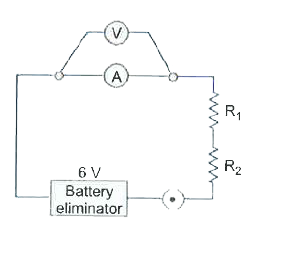Two students perform the experiment on series and parallel combinations of two given resistors R1 and R2 and plot the following V-I graphs (a) and (b).
Which of the graphs is (are) correctly labelled in terms of the words 'series' and 'parallel'? Justify your answer.

(a) Slope VI=Resistance R
As larger resistance represents series combination and smaller resistance the parallel combination. Therefore, graph of greater slope represents series combination and hence it is correctly labelled.
(b) Slope IV=1R
As larger resistance represents series combination, so graph of smaller slope represents series combination and hence it is also correctly labelled.
Topper's Solved these Questions
- ELECTRICITYBOOK - VK GLOBAL PUBLICATIONCHAPTER - ELECTRICITYEXERCISE - SOME IMPORTANT NUMERICALS
12 Videos
- ELECTRICITYBOOK - VK GLOBAL PUBLICATIONCHAPTER - ELECTRICITYEXERCISE - NUMERICALS (RESISTANCE AND RESISTIVITY)
23 Videos
- LIGHT-REFLECTION AND REFRACTIONBOOK - VK GLOBAL PUBLICATIONCHAPTER - LIGHT-REFLECTION AND REFRACTIONEXERCISE - PROFICIENCY EXERCISE (Long Answer Questions)
5 Videos
Similar Questions
Two students perform experiments on series and parallel combinations of two given resistors R1andR2 and plot the following V -1 graphs [Fig. 5.24.]. Which of the graphs is/are correctly labeled in terms of the words 'series' and 'parallel'? Justify your answer.

View SolutionTwo students perform experiments on series and parallel combinations of two given resistors R1andR1 and plot the following V -1 graphs [Fig. 5.24.]. Which of the graphs is/are correctly labeled in terms of the words 'series' and 'parallel'? Justify your answer.

View Solution
Knowledge Check
For students performed experiments on series and parallel combination of two given resistors R1and R2 which obey Ohm's law and plotted the following V-I graphs :

Which of the graphs is correctly labelled in terms of 'series' and 'parallel' ?Agraph ABgraph BCgraph CDgraph DTwo students perform experiments on two given resistors R1andR2 and plot the following V-I graphs. If R1>R2, which of the diagrams correctly represent the situation on the plotted curves?
A B
B C
C D
D
Consider two resistors R1 and R2 in series. The current flowing through R1 and R2 is
AR1=/,R2=2/BR1=/2,R2=1/2CR1=/,R2=/DR1=1/2,R2=2/
Two students perform experiments on two given resistors R1 and R2 and plot the following V-I graphs. If R1>R2 which of the two diagrams correctly represent the situation on the plotted curves? Justify your answer.

View SolutionIn an experiment to find the equivalent resistance of a series combination of two resistors R1 and R2,a student uses the circuit shown here. Will the circuit give the correct reading for current I and voltage V ? Justify your answer.

View SolutionWhen two resistors are in parallel combination then determine i1 and i2 if the combination carries a current I ?

View SolutionWhen two resistors are in parallel combination then determine i1 and i2 if the combination carries a current I ?

View SolutionFigure shows charge (q) versus voltage (V) graph for series and parallel combination of two given capacitors.The capacitances are :

View Solution
